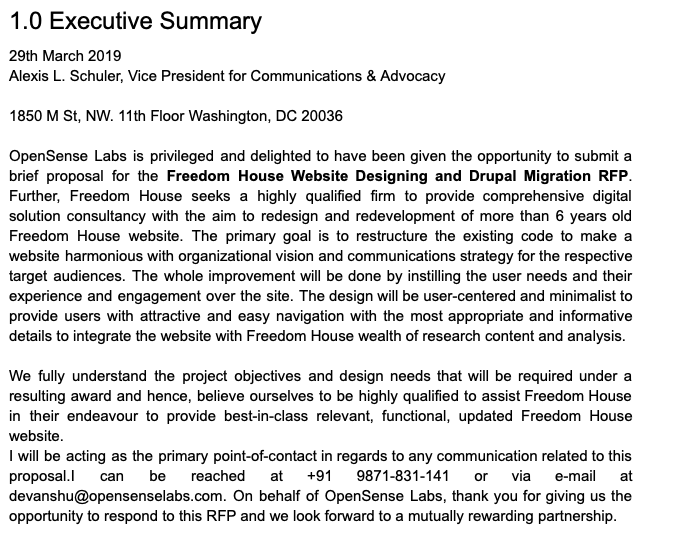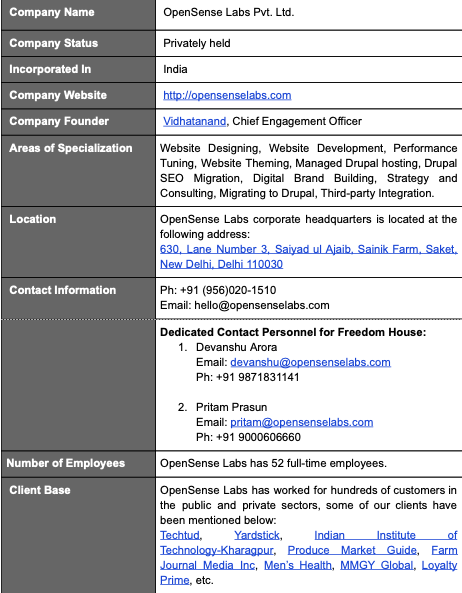Every RFP represents your company and crafting a good proposal is though, it is really challenging to just feel confident about it every now and then. Good proposals are mere hit and trials. They embark upon great work relationship between the two parties.
Where can you improve in your responses ?
1. A compelling executive summary
This section is pretty straightforward. It’s an introduction to your company, your values, and also an overview of the project you’re seeking bids on. An executive summary has basically nothing to do with product presentation, and everything to do with a persuasive sales pitch. It is far more than an abstract which merely presents the rest of the document.
Here’s an example of Executive Summary:

2. About your business and it’s background
What is your business doing and where. How can the current portfolio help the vendor seeking organisation in the services they seek? Tell them as much as they should know, about the team size, and resources to help the project, as in the example below:

3. How can the project goals be met?
How would be go about the project? Can you allocate better resources in the scenario of a critical situation or emergency? How can you make it more optimised, how can you deliver as per the proposed timelines? How much effort will it require to achieve some milestones? Answer all these questions in regards to the project goals, don’t let them fonder over any little
thing.
4. Always make recommendations
Recommendations are prime to your established niche in the industry and making recommendations helps your establish a foundation to further offer your services and prove your team’s skillset.
5. The Technical Solution Part
It’s pretty given that if any organisation releases and RFP, there is still an underlying problem they are trying to address and to lay forward your nice expertise and cause, you should provide a brief of the solution which should serve their need in the most economical and logical way within the timeframes set by them. Lay special emphasis on the technical solution angle and make it appear to be the best of your response, just try to make it stand out, it should be clear and loud.
6. Who’s the team and do they contribute?
The entire team which is going to be deployed on the project needs to be made transparent in the response itself, their certifications, expertise, experience, details, how long have you been seeking their services, is it contract based outsourcing or are they your in-house staff. The better your explanation and elaboration on the team’s profile and achievements as a whole, the better your chances of garnering their due attention, they always want to know the people they will be working with.
7. Can you meet the scope of work and deliverables on time?
It’s important that you are as clear as possible about what you want the project to include and the expectations you have for the work. This section of your RFP should be the most thorough (which means it’s going to be the longest.
8. How do you plan to manage the project inside out?
Are you deploying an in-house project manager or These things are extremely necessary. Potential clients either will deploy project managers or ask you to have one. Because they cannot risk things going off track as the project might be very critical. Give them a general project management practise insight, like.
- Mention that you use Agile Development Methodology and Scrum principles as a method for project development and prototyping.
- How do you generally kick off development, engagement and introduce the resources and project plan and timeline?
- Explain the suite of products you use - The project plan and tasks are then entered into JIRA - The project management tool to be used for project tracking. Our JIRA practices ensure that we have effective safeguard to ensure proper risk management and project integrity.
- Give a brief on the aggressive plan you have in mind - As per the timeline the project is divided into Sprints - a collective of tasks to be completed in a tenure of 2 weeks.
- Tell them about your communication frequency - Then a common window is identified and a regular checking call is scheduled to provide regular updates and share progress.
- You guys must be having demo - At the end of each sprint, as part of deliverables, a DEMO is scheduled where they are presented to the concerned stakeholders.
- Talk about Mega Meetings - There is a special meeting organised at the end of each Sprint as a retrospective which is used to take process feedback and ensure the following Sprints goes more smoothly.
- Add a note that you can deliver a better plan - The detailed project management approach will be shared with detailed proposal upon the request of the Freedom House.
That’s an airtight note to them! They won’t be needing anything more than this from any potential vendor.
9. Showcase Sprints
A Sprint is a time-boxed event in which the development team strives to achieve the goals outlined by the product owner in the form of a functioning product. A Sprint is the core of Scrum. A project is essentially divided into a series of consecutive sprints which leads to an iterative development process.
The tenure of a Sprint is usually 2 weeks at the end of which a product owner demonstration is scheduled and his/her feedback is collected. A Sprint comprises of tasks in the form of tickets which are moved in between a well-defined process until they are completed. JIRA - A project management tool is used to keep track of the Sprint and check Sprint metrics.
10. Give them a clear deliverable timeline
All deliverables should be self-explanatory wherever necessary so that they can be differentiated from related deliverables. For example:
- A twin engine plane versus a single engine plane
- A red marker versus a green marker
- A daily report versus a weekly report
- A departmental solution versus an enterprise solution
One of the project manager’s primary functions is to accurately document the deliverables of the project and then manage the project so that they are produced according to the agreed-on criteria. Deliverables are the output of each development phase, described in a quantifiable way.
Here’s an example list of deliverables for the entire project:
Phase I - Assessment & Planning - Deliverables
- Functional requirements documents
- Technical requirement documents
- Website design pages documents
- User Analysis
- Conceptual website architecture document
- Detailed Project Plan
- Timelines
Phase II - Site Architecture & Design - Deliverables
- Finalization of a CMS Product/Framework
- Wire-frame model of the proposed site
- Image snapshots for the proposed site
- Homepage
- Admin Page
- Other unique pages
Phase III - Site Development - Deliverables
- A mock website with most static data to get an idea of the overall end-user experience from site navigation perspective.
Phase IV - Implementation - Deliverables
- Architecture documents
- Design documents (sequence diagrams, design templates, database design models etc)
- Tested documents
- Tested components
- Manuals (operation, integration, deployment, installation, configuration, etc)
Phase V - Content Development & Migration - Deliverables
- Transition of SEO efforts
- Individually administered and transfer the content from several identified properties into a single repository
- Adherence to Google duplicate content tenets and rules
Phase VI - Integration Testing - Deliverables
- Documented Test Results
- Tested components
- Comprehensively Tested System
- Documented Issues with Prioritization
- QA Testing
Give them a closure on the deliverables as well. This way you will never lose out on them feeling that you don’t have a plan in mind.
Summing up
This is how you can deliver an interesting and promising response, regardless of the intricacy of the client’s project or financial capabilities. Success or failure is debatable but your RFPs will always be a confident document in itself and will always improvise to land more projects in the near future. You will be on an improvement trajectory.
However, for resource requirements related to your projects, you can always reach out to us at [email protected], we are always here to listen and address your concerns.
Subscribe
Related Blogs
In conversation with Danish Usmani, CEO, OpenSense Labs

In a year-end interview, CEO Danish Usmani showcases OpenSense Labs' achievements, emphasising new client partnerships and…
Why should you prioritize lean digital in your company?

We are living in an era where the change and innovation rate is just so high. If you want your organization to reach new…
How to measure your open source program’s success?

Along with active participation, it is very important to look after the ROI of open-source projects, programs, and…



